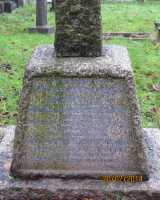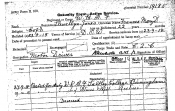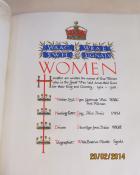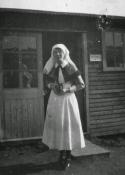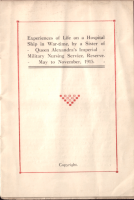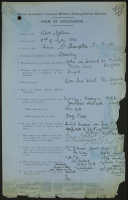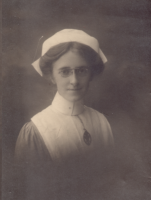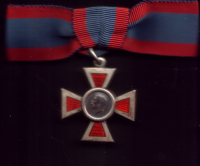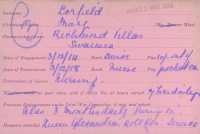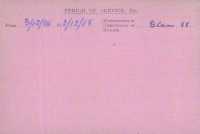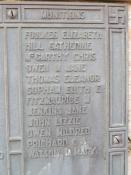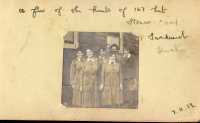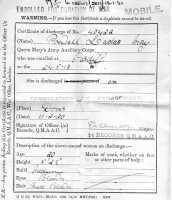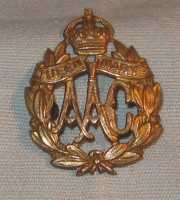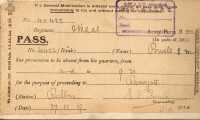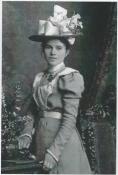Browse the collection
Sorted by date of death
Frances Mary Dulcie Llewellyn-Jones
Place of birth: Llandow
Service: Driver, WRAF, 1918:11:13
Death: Mexborough Military Hospital, Yorkshire, Influenza / Y Ffliw?
Memorial: Christchurch graveyard, Newport, Monmouthshire
Notes: Aged 22. Daughter of the Rev. David Ernest Llewellyn-Jones and Frances Eliza Sophia of Maindee Vicarage, Newport.
Reference: WaW0093
Margaret Ann Lloyd
Place of birth: Morriston 1894
Service: Munitions Worker
Notes: Margaret Ann Lloyd from Morriston (on the left) and friend (unknown) when they worked in the Mannesman Ammunition Factory manufacturing shells in Morriston – age early 20s. c. 1914-8
Reference: WaW0084
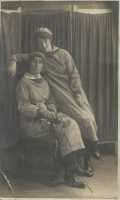
Margaret Ann Lloyd (L) and friend
Margaret Ann Lloyd (seated) and a friend, Mannesman Ammunition Factory, Morriston, c.1915 or 1916
Gertrude Madley
Place of birth: Llanelli, 1892
Service: Staff Nurse, QAIMNS Reserve / Wrth gefn, September 1916 - May 1920
Notes: Gertrude Madley was the daughter of a tinplate rollerman, and worked as a tinplate hand before training as a nurse in Swansea in 1913. She joined Queen Alexandra's Imperial Military Nursing Service Reserve as a Staff Nurse in September 1916. At just twenty-three years of age she was one of the youngest nurses to serve with the Reserve during the Great War. She served initally in Malta, and then, 1918 - 1920, in France
Sources: http://greatwarnurses.blogspot.co.uk/2014/09/from-small-acorns-mighty-oaks-grow.html
Reference: WaW0098
Alice Meldrum
Place of birth: Trevor Llangollen, 1880
Service: Staff Nurse, QAIMNS Reserve / Wrth gefn, 1914 - 1920
Notes: Alice Meldrum survived the sinking of the Hospital Ship HMHS Anglia 17th November 1915. The ship was carrying wounded men from Boulogne to Folkestone when it struck a mine. Alice's account reads:“We carried as many as possible on deck, and those that could threw themselves into the sea; others were let down in the lifeboat, but unfortunately it was only possible to lower one boat, as the ship was sinking so rapidly. The patients kept their heads wonderfully, there was no panic whatever, and when one realises that in the vast majority of cases they were suffering from fractured limbs, severe wounds, and amputations, it speaks volumes for their spirit, their grit and real bravery for they must have suffered agonies of pain. After we had satisfied ourselves that there was no possible chance of getting any more patients out, for by that time our bows had quite gone under, and only the ship’s stern was above water, with the propellers going at a terrific rate and blinding us with spray, we then got down onto the rudder and jumped into the sea……”. Three hundred wounded and crew were saved by naval and other ships in the area. She wrote 'there was a humourous side to it, for we must have looked very weird in the different garments that had been so kindly supplied to us by the officers and men of the destroyers, who did everything in their power for our welfare……..I would remind you that 40 minutes in the water in November is not the kind of sea-bathing that many would indulge in from choice …….After a good meal on the Ambulance Train, we were soon on our journey to London.”. Alice Meldrum was awarded the Royal Red Cross, and also wrote a short account of her experiences. She spent the remainder of the War working at field hospitals in France.
Sources: http://greatwarnurses.blogspot.co.uk/2009/11/sinking-of-hospital-ship-anglia.html
Reference: WaW0101
Mary Morgan (née Corfield)
Place of birth: Swansea
Service: Nurse, VAD
Notes: I nursed during World War I, in the YMCA building. It lent itself to be a hospital, it was never used before. We worked right through from 6 am to 2 pm. Eventually we had little single bedrooms upstairs, could sleep there, so worked full time – all day from 6 to 10.30, with a midday meal. I slept there. We worked hard, had to do what we were told. Second World War was very different. I nursed during World War I, in the YMCA building. It lent itself to be a hospital, it was never used before. We worked right through from 6 am to 2 pm. Eventually we had little single bedrooms upstairs, could sleep there, so worked full time – all day from 6 to 10.30, with a midday meal. I slept there. We worked hard, had to do what we were told. Second World War was very different. There were officers from the war, we had to take orders from them, had to stand up, but WWII was quite different. Went to the workhouse (on Mount Pleasant) for training in the early days. Before the YM, go to casualty ward in Swansea Hospital – we saw a lot. The soldiers went straight to the YM from the docks or the station. They seemed to by-pass London. Bad cases by boat to Swansea and Cardiff by sea. We saw some terrible injuries. One thing I hated doing ... Blood didn’t worry me – dressing the empty sockets of eyes. We did work hard....There were not many things for young women – some drove cars ... got into khaki. Father never let me leave home, but nursing during the war was different. He gave me a good allowance - £60 a year. Father said to me, you’ve got to look after yourself, and don’t you get into debt. I did love it [nursing]. We did pull our weight. We had to take orders from people we’d have looked down our noses at [before]. We were just ordinary VADs, war was war. We kept in touch with quite a lot of the men.
Sources: Recorded at Bloomfield Care Home, Sketty by Jenny Sabine, c. 1990
Reference: WaW0124
M Jane Owen
Service: Munitions Worker
Memorial: Cenotaph, Swansea, Glamorgan
Reference: WaW0041
Doris Patterson
Place of birth: Swansea
Service: Munitions Worker
Notes: Aged 34. Doris Patterson witnessed the explosion that killed Gwenllian Williams and Eleanor Thomas, and was uninjured although she was only 'two yards away'.
Reference: WaW0095
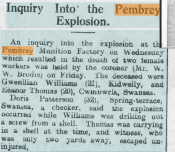
Witness account of explosion
Newspaper account: Doris Patterson's witness account of explosion, South Wales Daily Post 18 January 1919
A M Davies
Place of birth: Llanharan
Service: Nurse, Not known / anhysbys, 1915 - 1918 ?
Notes: Miss Davies, a professional nurse spent 18 months early in the war at Lady Hadfield’s Hospital at Wimereux, France (later No 5 British Red Cross Hospital). She later worked at the Welsh Hospital, Netley. She was awarded the Royal Red Cross in January 1918.
Reference: WaW0393
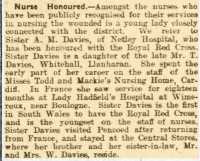
Newspaper report
Report of Nurse A M Davies’s award of the Royal Red Cross. Glamorgan Gazette 18th January 1918.
Ladas May (Known as Gladys WAAC / in Gelwid yn Gl Powell ( later Pritchard)
Place of birth: Cwmaman
Service: Worker, WAAC/QMAAC, 24/05/1918 - 11/02/1920
Notes: Ladas Powell joined the WAAC underage. She served at Stonar Camp, near Sandwich, Kent. Ladas, or Gladys as she was known in the WAAC, kept an album with photographs and documents in it as well as entries by friends and colleagues.
Reference: WaW0044
Arvona (Fona) Powell Jones
Place of birth: Gorseinon July 10th, 1913
Service: Small child
Notes: Fona confirmed her address and date of birth: July 10th, 1913. She recalled a story about her mother during the First World War asking her, because her father had received call-up papers, ‘You don’t want your father to go to war do you? She replied’ ‘Oh! Yes!’, because she had seen her uncle, who was at sea, in a uniform with a whistle around his neck. She thought therefore that her father would have a uniform and a whistle too. So she was delighted at the prospect of her father dressed in a uniform and whistle. But she remembers her mother’s face falling. ‘Oh! She was terribly disappointed that I had said that I wanted my father to go to war.’ But her father worked in the steelworks and since steel was required during the war he worked there for the duration of the war. Her parent’s names were Mary Ann Powell and Richard Jones; her father came from Cydweli and her mother was local to Gorseinon area. Her father had worked in the steelworks in Cydweli too. She also talks of her uncle, Brynmor, who was in the navy and who hated the war. At the end of the war he gave his navy clothes to her mother and told her to do what she wanted with them. She made Fona a dress from the bell-bottoms – they were of serge and added flowers etc onto it. She wore it all the time – to chapel and all. This was when she was about 5-6 years old. She remembers wearing it and swinging of a tree branch in it. Her mother’s brother (Tom in 1915 according to the family’s family tree)) died of typhoid in Crystal Palace during the war and she has a photograph of a wedding during the war with the men dressed in black in memory of him. Another of her mother’s brothers (Baden) was called up but when he arrived at the mess plates were being thrown all over the place. The Armistice – peace agreement had just been signed. And that’s all he saw of the war. Fona also recalled how, for the duration of the war, her mother removed a model of an eagle which was on top of the family’s grandfather clock and stored it away in a drawer, because it was a reminder and symbol of Germany. After the war it was restored to its place on top of the clock! ‘Memory is a strange thing isn’t it.
Sources: fona_jones_gorseinon.wave_sound
Reference: WaW0075
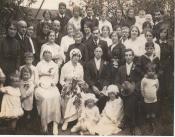
Fona Jones bottom left (blurred) at family wedding.
A family wedding showing a blurred Fona Jones, bottom left. The women were all dressed in mourning for Fona's uncle Tom, who had died in 1915.

